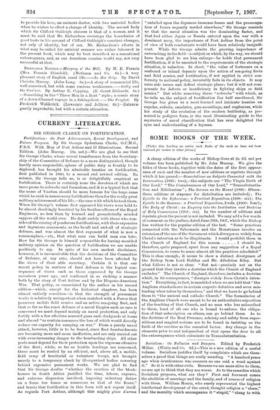CURRENT LITERATURE.
SIR GEORGE CLARKE ON FORTIFICATION.
Fortification : its Past Achievements, Recent Development, and _Future Progress. By Sir George Sydenham Clarke, G.C.M.G., F.R.S. With Map of Port Arthur and 57 Illustrations. Second Edition. (John Murray. 18s. net.)—We are glad to see that Sir George Clarke, whose recent transference from the Secretary- ship of the Committee of Defence to a more distinguished, though hardly more responsible, sphere of public duty is frankly to be deplored, has brought his admirable treatise on fortification, first published in 1890, to a second and revised edition. No science, Sir George tells us, is so delightfully empirical as fortification. There is certainly none the devotees of which are more prone to cobwebs and formalism, and it is a typical fact that the name of Vauban should be more famous for the huge sums which he sank in unnecessary fortifications than for the really great military achievement of his life,—the ease with which he took them. When Sir George's volume first appeared his views were held to be almost shockingly heretical by his brother-officers of the Royal Engineers, no less than by learned and geometrically minded sappers all the world over. He dealt rudely with those who con- sidered the raising of ponderous fortifications, with their expensive and ingenious armaments, as the be-all and end-all of strategic defence, and was almost the first exponent of what is now a commonplace,—viz., that what man can build man can take. How far Sir George is himself responsible for having moulded military opinion on the question of fortification we are unable positively to say. In spite of his own modest disclaimer, however, it is inconceivable that the decisions of the Committee of Defence, at any rate, should not have been affected by the views of their able secretary. Certain it is that our recent policy in matters of land defence is the logical con- sequence of views such as those expressed by Sir George seventeen years ago, and confirmed in so striking a manner both by tho story of Port Arthur and by the Hispano-American War. That policy, as enunciated by the author in his second edition—which, except for the historical chapters, has been almost entirely rewritten—is that the strength of permanent works is relatively unimportant when matched with a Power that possesses mobile field armies and an active sea-going fleet, and that so far as the coast defence of a naval Empire such as ours is concerned we must depend mainly on naval protection, and only fortify with a few effective seaward guns such dockyards at home and abroad "as contain resources the loss of which would directly reduce our capacity for carrying on war." From a purely naval attack, however, little is to be feared, since fleet bombardments are becoming more and more ineffective, and are only carried out with ever-increasing danger to the bombarding ships. All other ports must depend for their protection upon the vigorous offensive of the fleet; while, so far as hostile landings are concerned, these must be routed by an efficient, and, above all, a mobile, field army of territorial or volunteer troops, not brought merely to a temporary check by ill-organised bodies cowering behind expensive permanent works. We are glad to find that Sir George doubts "whether the erection of the block- houses in South Africa justified the time, labour, expense, and extreme dispersion involved, imposing sedentary duties on a force ten times as numerous as that of the Boers," and trusts that fortification in this form will not repeat itself. As regards Port Arthur, although this mighty place d'armes "entailed upon the Japanese immense losses and the preoccupa- tion of forces urgently needed elsewhere," Sir George reminds us that the naval situation was the dominating factor, and that had either Japan or Russia entered upon the war with a dominant navy, the importance of Port Arthur from the point of view of both combatants would have been relatively insignifi- cant. While Sir George admits the growing importance of entrenching in the field—a subject on which, by the way, we should have been glad to see him enlarge—he holds that permanent fortification, if it be unsuited to the requirements of the strategic situation, is valueless. In short, "the value of fortresses on a seaboard or inland depends upon the action of sea-going fleets and field armies, and fortification, if not applied in strict con- formity to national policy, invariably fails in its objects. It may raise side issues and deflect strategic plans; but it will not com- pensate for defects or insufficiency in fighting ships or field armies." But while removing these "cobwebs" with which, as he tells us, the subject of fortification lies half smothered, Sir George has given us a most learned and intricate treatise on cupolas, reduits, enceintes, gun-mountings, and explosives, while his study of the evolution of the modern battleship, as pre- sented in pedigree form, is the most illuminating guide to the mysteries of naval classification that has ever delighted the eyes and understanding of a layman.






































 Previous page
Previous page